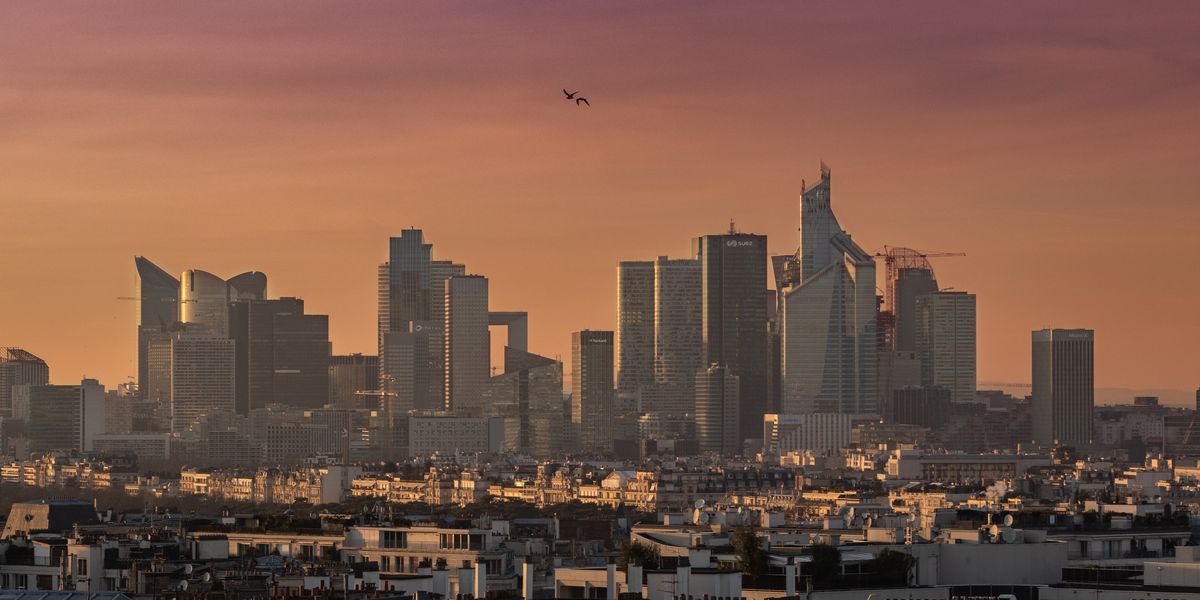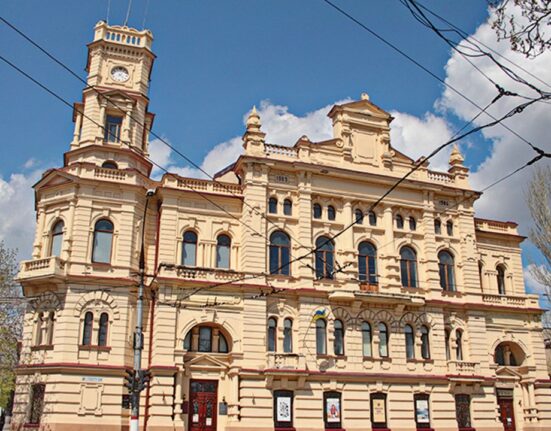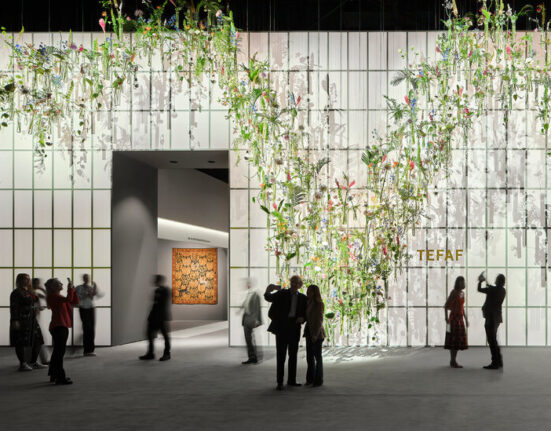PARIS — The days when Khadija served copious ribs of beef and bottles of fine wine to executives in suits feel like ancient history. The restaurant, located in “Les Quatre Temps” shopping center in the La Défense district near Paris, has had to adapt to a radically new world. “We have removed all the meats that are too expensive from the menu, no one orders them anymore”, Khadija says mournfully, adding that the restaurant’s clientele has shrunk a lot from its glory days.
The advent of remote work has pushed businesses in this neighborhood into a mortal crisis. “Fridays, which used to be good days for us, have become catastrophic,” Khadija says. She then goes on to list all the restaurants in the area which have permanently shuttered.
A few meters down the road, Julianna, manager at a ready-to-wear store, remembers the days when it took five people to tend to customers. “Today, two employees are enough,” she says. “Our turnover has fallen by almost 60% in two years.” She also lists the neighboring businesses which have closed down, from clothing and lingerie outlets to ice cream parlours. Clearly, the carnage hasn’t spared anyone.
Maxime Lévy can only agree. Ten years ago, Lévy’s Forestland store had to sometimes close its gates in the middle of the day to control massive crowds. “It’s becoming more and more complicated to do business here,” he admits. In front of her storefront, this hairdresser reckons her clientele has been halved since COVID. She says she is crossing her “fingers, hands, feet, everything, for business to resume soon.”
Post-COVID Lethargy
What’s eating Europe’s largest business district? La Défense has long been a source of French pride. Its name refers to the statue La Défense de Paris, erected in 1883 to celebrate Paris’s victory over Prussian siege during the Franco-German war of 1870. But a deathly lethargy seems to have set into this once buzzing neighborhood since COVID.
The prime culprit is the switch to remote work. On Mondays, and even more so on Fridays, it is hard to find a trace of the 180,000 employees officially working in this 566-hectare territory. The peak hour rush of employees at the train station is now a rare scene. (On the brighter side: finding a seat on the morning train is no longer a challenge.)
But this development also seems symptomatic of the slow death of a territory that was once the symbol of radiant success. In the district’s office buildings, many spaces lie unoccupied. The vacancy rate is said to be around 15%.
Of course, France’s third largest bank Société Générale, construction materials and services multinational Saint-Gobain, and petroleum giant TotalEnergies are still part of the landscape, together with over 500 companies, including 14 in the CAC 40. But several big names have recently defected or announced the termination of their leases. These include Thales, now settled in Meudon in the southwestern suburbs of Paris, and Mazars and EY, who are due to leave in 2025. Electric utility company EDF, for its part, has reduced its presence by more than a third.
“It’s true that this neighborhood doesn’t really have a soul,” say two young employees of an insurance company in the middle of a cigarette break in front of one of the 61 “high-rise buildings” in the area – a very specific description assigned by architects (some 40 buildings in the area are over 100 meters high). “We come here for work and as soon as we’re done, we leave,” they summarize.
Valentin, a 30-year-old executive working in the energy sector, agrees: “I really like urban centers, including business districts in other countries, but I have never felt the slightest excitement when coming to work here because we are cut off from the city. It is a place solely dedicated to work, [an isolated] space with no continuity with its environment.”
Coming to La Défense is now a matter of necessity. “No one talks about it too much. We have to respect the place where some of us are likely to spend most of their careers, but it is obvious that we are neither happy nor excited to be there,” adds Valentin.
“The Very Concept of Business Districts Is Coming To An End”
COVID, as often, is partly to blame, but it also helped uncover deeper structural problems. The camel’s back was already overloaded, the pandemic was just the last straw.
For several years now, urban planners, sociologists, anthropologists, and administrators have converged on the same nagging question: Is a district, designed in the middle of the economic boom, projecting power, minerality, and triumphant capitalist excess still relevant? Sylvie Prunier-Poulmaire, lecturer in work psychology and ergonomics at the University of Paris-Nanterre, notes that “the verticality of the La Défense’s towers seems far from the model of horizontality younger generations are looking for.”
“This hyperconcentration of human activities does not fit the real aspirations of most people.”
Jean-Christophe Fromantin, mayor of the neighboring city of Neuilly-sur-Seine, points at the same dissonance: “We must never forget that the first skyscrapers were built to demonstrate the economic power of the companies that financed them.” The first city councilor is currently working on a thesis on La Défense.
The tower as an architectural object appears far removed from current structures that code collaboration. “The digital economy is seeded in the dispersion of economic activities and a principle of horizontality which, in a sense, condemn verticality,” continues Fromantin for whom “it is the very concept of business districts which is coming to an end.” He continues: “A few years ago, many were betting on metropolises as the future. But the truth is, this hyperconcentration of human activities does not fit the real aspirations of most people, who want to live closer to nature and in cities with a human scale.”
Quite the antithesis, then, of a neighborhood built on a gigantic slab of concrete and designed to fully embrace its disconnection from its environment. “Even when you green the area, it is impossible to obtain either the depth or the critical mass of plants, and all you have is just potted trees,” says Sylvain Grisot, co-author with Christine Leconte of the book Réparons la ville! (Let’s fix the city!).
According to Grisot, the “monoactivity” of La Défense is the main cause of its fragility today. The urban planner explains that this territory “is associated with the development of the service industry, revolving around a place, an office, and a tool, the central computer.” However, “we can clearly see that we have become detached from the office over the last 10 years, ever since the smartphone allowed executives to access their email from anywhere.”
In the age of shared spaces, the office becomes “the last place where you can really work, since you disturb your neighbors with video calls,” Grisot adds. Prunier-Poulmaire of the University of Paris-Nanterre confirms: “In our surveys, some people tell us that they would gladly work at the head office of their company, but for this to happen the head office in question would have to be a truly social place.” She mentions the “double isolation” of contemporary settings: you’re alone at home, but also alone among your peers with headphones glued on to their ears.
The Progressive Partitioning Of Work And Private Life
For Sonia Lavadinho, urban anthropologist and founder of the firm Bfluid, a site like La Défense “only echoes a rather thin side of our personalities”. For a long time, the identity of an individual has been closely associated with their productive function in society. “Whether at the church or in the fields, you were the baker or the notary for the others,” she explains.
She takes up the theory of “multiple personalities” transposing it to the contemporary era and work sphere. “The self that you embody at work today is only a part of what defines you, and young people no longer want to be only a part of themselves in the [workplace].”
With COVID, La Défense opened its eyes to a “groundswell that has been underway for around 50 years”, with the progressive partitioning of work and personal life. Less and less time to have lunch with your loved ones, more and more time in transport, all within a logic of commuting “which would have seemed incongruous to our ancestors”.
In total, commuters “spend seven or eight years of their life [commuting], which generates, as research has proven, excessive stress,” Lavadinho adds. It decreases your commitment at work and participation in the civic life of the municipality where you live, as well as in your home life. “That would explain why workers from La Défense are having such a hard time giving up on remote work.”
Even the management of Paris La Défense, which supervises the district, agrees that a change of direction is necessary. In an invigorating exercise of transparency, Pierre-Yves Guice, general manager of the public establishment, readily concedes the obsolete nature of La Défense: “If we were to build a business district today, it is clear that we would do it differently.” “We have undoubtedly gone a little too far with the monofunctionalism,” he says from the 18th floor of the elegant Coeur Défense tower, a 161 meter giant which embodies the excesses of the district, and which was bought for more than 2 billion euros by a bank called… Lehman Brothers.
Insurmountable Physical Limits
The neighborhood has survived crises induced by the spasms of the global economy, but its current rut goes further. As Pierre-Yves Guice recognizes, for the first time, the aura of La Défense must confront insurmountable physical limits.
“This is the question driving all our actions. We can no longer artificialize the land, we can no longer pretend that energy is unlimited, we can no longer consider that public money will continue to flow freely and, more generally, the whole paradigm of infinite economic development is declining in our minds. Employees themselves no longer have the same devotion to the god of economic activity.”
Yet, the very functioning of La Défense led it straight into a wall. For decades, the infrastructure here was largely financed with the income generated by the construction of new towers. Continuing on this path, when the space available for construction has shrunk dramatically, is simply not sustainable. “For a very long time, the system was quite similar to a Ponzi scheme, financing the present with the future,” Pierre-Yves Guice says.
Whether seen from a financial, ecological, urban planning, or sociological perspective, debates and discussions always lead to the same conclusion: If it does not reinvent itself, La Défense will collapse.
Leveraging Its Strengths
A response is in the works. For several years now, Paris La Défense has been running projects that seek to better integrate the district into the city, diversifying its activities to include sport, catering, and culture, greening the area, and creating interconnections between the towers to limit the isolation between these vertical worlds so they no longer ignore each other.
All this while defining a development strategy for this territory in search of identity: becoming the first post-carbon business district.
The objective is ambitious because, as Pierre-Yves Guice detailed at length during the General Meeting of the Towers last June, the vertical buildings of La Défense are a grid of various interlocking handicaps: carbon-intensive construction, structurally energy-intensive operation, a style of functioning not tailored to new uses, poor public accessibility, and too few shared services. And now, a million square meters, which means more than a quarter of buildings, is set to become obsolete.
The territory is being forced to go out of its comfort zone to reinvent itself.
What is the way out? Here again, old tricks have reached their limits. “The easy solution from a cognitive point of view would be to tear everything down, but we have to be much smarter than that,” says Lavadinho of Bfluid. Given the quantity of carbon dioxide emitted during the construction of the towers, it is essential that they are renovated in the light of new energy and sociological imperatives.
Lavadinho points out that this approach, necessarily progressive and modest, comes up against a sense of urgency, both environmental and demographic. “The last generation of baby boomers will retire in the near future, and we therefore have around 10 years to prepare for this structural shock, which is very little in terms of urban planning.”
Faced with an almost existential danger, the territory is being forced to go out of its comfort zone to reinvent itself. But it must also rely on its strengths that have stood tall thus far.
Says Pierre-Yves Guice: “France remains a service-driven economy, and if we consider that the best way for it to emerge from the crisis it is going through is to bank on its economic driving forces, then La Défense, as the main business district of Paris and its surroundings, is clearly part of the solution.”
:This heritage is there, we have to embrace it”, he insists. To give up on making the most of it when colossal sums of public money have been invested in it would be like saying that “we must stop nuclear energy tomorrow morning, we simply cannot afford it.”
What are the inherent strengths that La Défense can capitalize on? First, it has a unique transport network including metro, RER (suburban trains), and regional trains which provides access to a district holding several European records: the largest office space (3.7 million square meters), the largest shopping center, and the largest capacity for an indoor concert hall (Paris La Défense Arena can accommodate up to 40,000 people). All this at the heart of a region which alone provides nearly a third of French GDP.
For Virginie Picon-Lefebvre, professor at the Paris-Belleville National School of Architecture, this territory “still has something exceptional, close to national heritage. Very few business centers in the world are as coherent as La Défense and offer 35 hectares of car-free space.”
Sure, when it comes to greenery, the district pales in comparison to its international counterparts. But if you go for a midday walk along the esplanade on a sunny day in June, you’ll see countless groups of executives picnicking in the shade of the trees or playing Swedish pétanque.
For Adrien Teurlais, journalist in charge of the site defense-92.fr, “We must stop with the excessive criticism of this district. In terms of vegetation for example, La Défense is clearly much better than Paris.”
Stopping The “Demonization”
Working in the center of the capital is still more tempting for executives, but one has to stay clear-headed about the saturation of this real estate market. “Renting a square meter of office in Paris costs 800-1,000 euros, compared to 500 euros in La Défense, and it is clear that working here is not half as bad,” Pierre-Yves Guice says, highlighting the appeal of La Défense compared to more peripheral towns in the Paris region, where companies are struggling to recruit.
The pitch seems to be working: The chemical company Arkema, the car rental company Avis, Bureau Veritas, Siemens, the glasse manufacturer Afflelou, the Omnes group specialized in higher education are among the new arrivals in La Défense.
Rentals have had two prosperous years in 2021 and 2022. But practices are changing. The days when capitalist behemoths rented an entire tower are coming to an end, as smaller companies opt to lease one or more floors.
“The project was subsequently associated with triumphant capitalism.”
This practice, unthinkable 10 years ago, has fueled the diversification of the district’s worker profiles, meaning financiers and engineers are no longer the only employees in the area. You will also meet students on the famous parvis: La Défense proudly hosts around 30 higher education establishments with nearly 70,000 pupils, a figure that is growing rapidly. “It’s twice as much as the university district of Jussieu in Paris, but it’s much less known,” Pierre-Yves Guice says.
Isn’t this, in fact, the crux of the problem? Will it be fair to say that La Défense suffers from a reputation problem which is partly beyond its control? Picon-Lefebvre of the Paris-Belleville National School of Architecture has a hypothesis: France saw a shift towards a “hatred for modernity” in the mid-1960s. As proof, she cites the movie Playtime by Jacques Tati which, in 1967, suddenly “made a mockery of the architectural modernity embodied by La Défense.” Not a month goes by “without the destruction of a building from the 1950s or 1960s in Paris, even though some are magnificent”, she says.
According to her, since its gestation, La Défense has suffered from this very French ambiguity. “During its construction, it received bad press and the project was subsequently associated with triumphant capitalism, to the point that for my architecture teachers trained after 1968, La Défense had even become a taboo subject. This demonization never completely disappeared.”
“Accept This Architecture As Part Of Our History”
Laurent Pereira, an architect who taught for many years in Soul, speaks of the clear cultural differences in the perception of modernity between that city and Paris. “It is not about pretending that everything from the 1950s or 1960s is [still] relevant but about accepting this architecture as part of our history. [Denying that] is as unproductive as asking whether the Haussmannian Paris was a mistake or whether building fortifications in the Middle Ages was a bad idea.”
He warns against the current temptation to brush aside the aesthetics of verticality, glass, and concrete. “In the 1970s, we thought that destroying Art Nouveau buildings in Belgium was the right thing to do.”
Giving new meaning to Europe’s largest business district means carrying out proactive reforms to better integrate it into its surrounding and era. But also, perhaps more profoundly, to have a vision for the long term.
From the beginning, La Défense has been part “of the historical logic of the expansion of the capital,” writes Bertrand Pac in a thesis on the subject. Indeed, “in the 1550s, Paris started building towards the west, a movement which accelerated considerably in 1667, when Le Nôtre imagined the Champs-Elysées at the instigation of King Louis XIV.” From this perspective, La Défense might not be a wart disfiguring the city, but the final stretch of an arc that spans eras and architectural trends.
And which bears, whether we like it or not, traces of some French darings.
From Your Site Articles
Related Articles Around the Web









